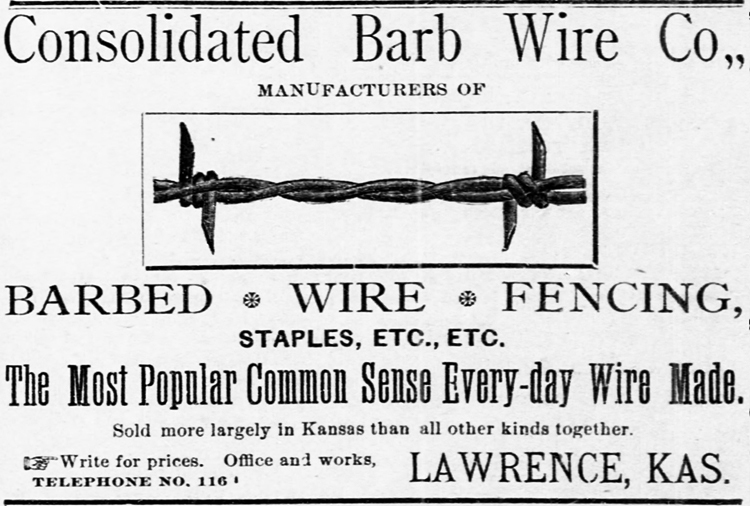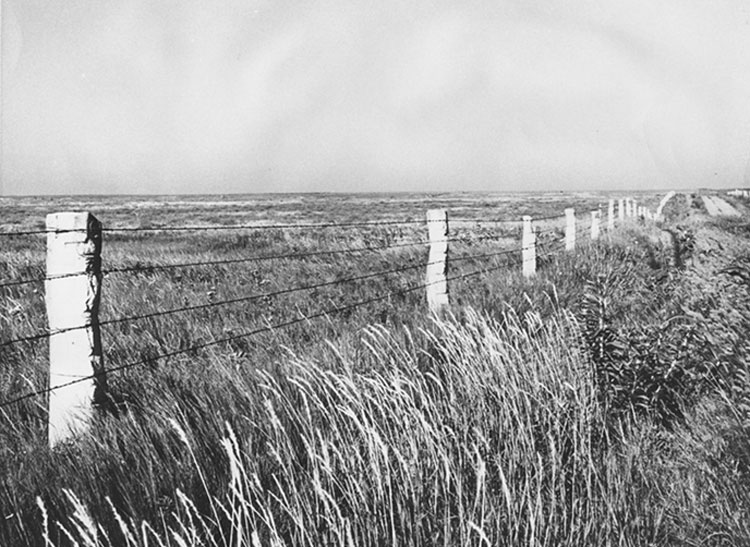Settling the Kansas Prairies—With Barbed Wire
During the settlement of the Midwest, local company eased pain of building fences on treeless prairies to keep livestock contained.
| 2017 Q2 | story by Patricia A. Michaelis, Ph.D., Historical Research & Archival Consulting
Photos from the Kansas State Historical Society, kansasmemory.org

Consolidated Barb Wire Co.
A Lawrence manufacturing company—Consolidated Barb Wire Co.—made an important contribution to the settlement of western Kansas and adjacent states. The treeless prairies made it difficult for farmers to build traditional wooden fences to keep in domestic cattle and to keep out buffalo and Texas longhorns being driven to railheads in Abilene and later Dodge City. The solution to this problem was the invention of barbed wire by Illinois farmer Joseph Glidden in 1873. This invention, and numerous patented versions of barbed wire, made it possible to build fences with minimal lumber (or limestone in some parts of western Kansas) for fenceposts with several strands of barbed wire. The barbs on the wire were sharp enough to “discourage” livestock from destroying the fences. Use of barbed wire also lowered the cost of fencing dramatically, and farmers and ranchers “fenced in” larger pastures or ranges. The wire was attached to the posts in various ways, but building sturdy corner posts and having enough tension on the wire to prevent sagging were keys to fence-building.
Albert Henley founded the Lawrence Barbed Wire manufactory, the predecessor to Consolidated Barb Wire. Henley was born in Indiana and moved to Iowa, where he manufactured barbed wire on a small scale. He and his wife moved to Lawrence in 1878, where he continued to manufacture barbed wire. By 1882, he owned nine machines that produced 10,000 pounds of barbed wire per day. In 1883, Henley and several other small barbed wire companies merged to become Consolidated Barb Wire. The building housing the factory was 60 x 100 feet and two stories high. The first floor opened on a level with the railroad tracks so the wire could be unloaded and loaded easily.
In 1891, a new building was constructed. It had a 300-foot frontage and extended back 60 feet. This building was next to the Santa Fe Railroad tracks between New Hampshire and Rhode Island streets. While one story at street level, the west half of the building had a basement that was created from the bluff on which the building sat. The building was a combination of wood and brick. The brick portion housed boilers and other machinery, and was designed to be fireproof. The factory would employ 40 men, “all or nearly all of whom are heads of families, thus it will be seen this institution provides a means of subsistence for nearly two hundred people, indirectly.” The 1891 building still stands (Abe and Jake’s is housed there now) and is listed on the National Register of Historic Places as part of East Lawrence Industrial Historic District.
Initially, Henley imported wire from the east, and the company turned it into barbed wire. By the mid- 1890s, he began purchasing the steel rods to manufacture barbed wire from start to finish in his own plant with a machine he invented himself. The process first involved making and then galvanizing the wire to prevent rusting. The steel rods were heated, and the wire was “drawn.” An article in the Lawrence Daily Journal Nov. 16, 1898 described the galvanizing process as follows:
- The galvanizing process is an interesting one and this new department at the mill will be the occasion of many inquiries about the operation. After the wire is drawn to its proper size it is sent on to the galvanizing room without going through the annealing process. It is at once started through the furnace in this department and then on through the other processes that complete the operation. A furnace forty-eight feet long is the first thing the wire is introduced to. The furnace is built with an arched roof of special bricks, through which there are holes that the strands of wire may be drawn. These flues run the entire length of the furnace. The brick are kept at a white hot heat all the time, the furnace so arranged that the fire is drawn along underneath the arched brick, and then back over the top. As the wire comes out of the furnace it is red hot. After running twenty to thirty feet through the air it is doused through a water tank then a cold muriatic acid bath is given to the wire followed by another muriatic acid bath heated by steam. The wire then goes into a vat of spelter or zinc, and is there coated and becomes galvanized. As it comes out of this bath it is run through an asbestos wiper that removes extra zinc. The wire is cooled and cleaned by running through a final water bath and then goes to the machine where it is wound on spools.
The automatic wire machine took wire from three coils, twisted two of the strands together and attached barbs cut from the third to the twisted pair. The zinc from the galvanizing process came from mines in southeast Kansas, and Consolidated used 10,000 tons of zinc every 20 days.

Barbed wire on the prairie.
Henley’s business expanded beyond barbed wire to woven fencing, bail ties and nails, with barrels for the nails made locally by two companies: Railbe Brothers and Hauber Brothers. In the early 1890s, the “wire mill,” as it was known to Lawrence residents, employed approximately 150 people. However, difficulties were on the horizon. Large numbers of lawsuits over patents for wire had been disputed in the courts for years. In addition, American Steel and Wire Co. made several attempts to buy Henley’s plant, but he refused their offers. In the end, American Steel and Wire secured a monopoly and the steel rods used to make the wire. Apparently, the company threatened that it would not sell Henley the raw materials needed to make the barbed wire. Faced with this ultimatum, Henley sold Consolidated Barb Wire to American Steel and Wire in 1899.
Henley’s new business, the American Cement Plaster Co., produced cement plaster that was a mixture of suitable plaster, sand, Portland cement and water that is normally applied to masonry interiors and exteriors to achieve a smooth surface. He and his new company continued to have an impact on Lawrence’s economy. He also was involved in local politics, being elected mayor in 1888. He served as a state representative for two terms and as a state senator. Henley died in 1919, but Consolidated Barb Wire was the first factory in Kansas to manufacture this specialized wire. Because the business dominated the Kansas market, it can be credited for its impact on helping settlers operate farms and ranches in the prairies of western Kansas.




20 Comments
Thank you for the good writeup. It in fact was
a amusement account it. Look advanced to more added
agreeable from you! However, how can we communicate?
Please let me know if you’re looking for a article writer for your blog.
You have some really good posts and I feel I would be a good asset.
If you ever want to take some of the load off, I’d really like to write some material for your blog in exchange
for a link back to mine. Please send me an e-mail if interested.
Cheers!
Great post. I’m facing many of these issues as well..
Pretty! This was a really wonderful article. Many thanks for supplying this information.
Good post. I learn something new and challenging on blogs I stumbleupon on a daily basis. It will always be helpful to read through content from other authors and use something from other sites.
Spot on with this write-up, I absolutely think this web site needs much more attention. I’ll probably be returning to read more, thanks for the info!
I think that is one of the such a lot significant information for me.
And i’m glad studying your article. But want to statement on some common issues, The site
style is great, the articles is really excellent : D. Good task, cheers
Having read this I believed it was really enlightening. I appreciate you finding the time and energy to put this informative article together. I once again find myself spending a significant amount of time both reading and commenting. But so what, it was still worthwhile!
Good day! I could have sworn I’ve visited this site before but after browsing through some of the articles I realized it’s new to me. Anyhow, I’m certainly pleased I came across it and I’ll be book-marking it and checking back often!
I blog quite often and I seriously appreciate your content. This great article has really peaked my interest. I will book mark your blog and keep checking for new information about once a week. I subscribed to your Feed too.
You are so interesting! I do not suppose I have read through a single thing like that before. So good to discover someone with some genuine thoughts on this issue. Really.. many thanks for starting this up. This website is one thing that’s needed on the web, someone with a bit of originality!
The next time I read a blog, Hopefully it doesn’t fail me as much as this particular one. I mean, I know it was my choice to read through, however I truly thought you would probably have something useful to talk about. All I hear is a bunch of complaining about something that you can fix if you were not too busy seeking attention.
You made some good points there. I looked on the net to find out more about the issue and found most individuals will go along with your views on this site.
I was very happy to discover this site. I wanted to
thank you for your time for this fantastic read!! I definitely
appreciated every little bit of it and I have you saved as a favorite to
check out new things in your blog.
It’s hard to come by educated people on this subject, but you sound like you know what you’re talking about! Thanks
It’s in fact very difficult in this full of activity life to listen news on Television, so I just use web for that reason, and
take the hottest information.
Hi, I do think your web site might be having internet browser compatibility issues. Whenever I look at your blog in Safari, it looks fine however, if opening in Internet Explorer, it’s got some overlapping issues. I simply wanted to provide you with a quick heads up! Besides that, excellent website!
Howdy! I could have sworn I’ve visited this site before but after browsing through a few of the articles I realized it’s new to me. Nonetheless, I’m definitely delighted I stumbled upon it and I’ll be bookmarking it and checking back often!
Howdy! I could have sworn I’ve been to this site before but after looking at some of the posts I realized it’s new to me. Nonetheless, I’m definitely pleased I came across it and I’ll be book-marking it and checking back frequently!
After looking over a number of the articles on your site, I really like your way of blogging. I saved it to my bookmark website list and will be checking back soon. Please check out my web site too and let me know your opinion.